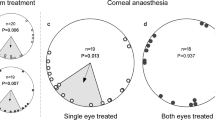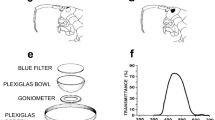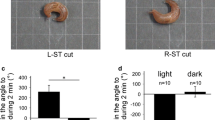Summary
Tiger salamanders (Ambystoma tigrinum) trained to orient in a particular compass direction under the sun fail to orient in the trained direction if they are (i) eyeless and simultaneously have the brain covered with opaque plastic or are (ii) eyeless and pinealectomized (Fig. 1–2, Table 1). Salamanders with either the eyes or the pineal intact and unobstructed continue to orient in the trained direction. These data strongly support the hypothesis that the pineal body is an effective extraocular photoreceptor (EOP) for compass orientation in tiger salamanders.
Similar content being viewed by others
References
Adler, K.: The role of extraoptic photoreceptors in amphibian rhythms and orientation: A review. J. Herpetol.4, 99–112 (1970)
Adler, K.: Extraocular photoreception in amphibians. Photochem. Photobiol.23, 275–298 (1976)
Adler, K., Taylor, D.H.: Extraocular perception of polarized light by orienting salamanders. J. comp. Physiol.87, 203–212 (1973)
Batschelet, E.: Statistical methods for the analysis of problems in animal orientation and certain biological rhythms. Washington: Amer. Inst. Biol. Sci. 1965
Batschelet, E.: Recent statistical methods for orientation data. In: Animal orientation and navigation (eds. S.R. Galler, K. Schmidt-Koenig, G.J. Jacobs, R.E. Belleville), pp. 61–91. Washington: National Aeronautics and Space Administration (publ. 262) 1972
Demian, J.J., Taylor, D.H.: Photoreception and locomotor rhythm entrainment by the pineal body of the newt.Notophthalmus viridescens (Amphibia, Urodela, Salamandridae). J. Herpetol.11, 131–139 (1977)
Dodt, E., Heerd, E.: Mode of action of pineal nerve fibers in frogs. J. Neurophysiol.25, 404–429 (1962)
Hamasaki, D.I.: Interaction of excitation and inhibition in the stirnorgan of the frog. Vision Res.10, 307–316 (1970)
Hartwig, H.-G., Baumann, C.: Evidence for photosensitive pigments in the pineal complex of the frog. Vision Res.14, 597–598 (1974)
Kelly, D.E.: Ultrastructure and development of amphibian pineal organ. Prog. Brain Res.10, 270–287 (1965)
Landreth, H.F., Ferguson, D.E.: Newts: Sun-compass orientation. Science158, 1459–1461 (1967)
Taylor, D.H.: Extraoptic photoreception and compass orientation in larval and adult salamanders. Anim. Behav.20, 233–236 (1972)
Taylor, D.H., Adler, K.: Spatial orientation by salamanders using plane-polarized light. Science181, 285–287 (1973)
Taylor, D.H., Ferguson, D.E.: Extraoptic orientation in the southern cricket frog,Acris gryllus. Science168, 390–392 (1970)
Twitty, V.C.: Migration and speciation in newts. Science130, 1735–1743 (1959)
Author information
Authors and Affiliations
Additional information
We thank M.P. Farrell for developing computer programs for data analysis. B. Bailey and R. Walton helped conduct tests. Financial support was provided for separate phases of this research by a Biomedical Science Support Grant (NIH FR 07033-05) and NSFgrants GB-30647 and BMS 75-18693 to K. Adler and an Indiana Academy of Science Research Grant, a postdoctoral fellowship (NSF GU-2058), a Miami University Research Grant and an NSF grant (GB-41102) to D.H. Taylor.
Rights and permissions
About this article
Cite this article
Taylor, D.H., Adler, K. The pineal body: Site of extraocular perception of celestial cues for orientation in the tiger salamander (Ambystoma tigrinum). J. Comp. Physiol. 124, 357–361 (1978). https://doi.org/10.1007/BF00661385
Accepted:
Issue Date:
DOI: https://doi.org/10.1007/BF00661385




